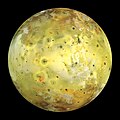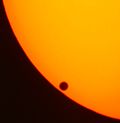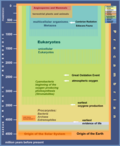The five-planet Nice model is a numerical model of the early Solar System that is a revised variation of the Nice model. It begins with five giant planets...
69 KB (8,550 words) - 21:02, 24 March 2025
In astronomy, the Nice (/ˈniːs/) model is a scenario for the dynamical evolution of the Solar System. It is named for the location of the Côte d'Azur Observatory—where...
47 KB (5,838 words) - 20:50, 13 February 2025
The Nice 2 model is a model of the early evolution of the Solar System. The Nice 2 model resembles the original Nice model in that a late instability of...
14 KB (1,884 words) - 22:40, 31 December 2024
Fifth Giant (redirect from Fifth Giant (hypothetical planet))
hypothetical ice giant proposed as part of the Five-planet Nice model, an extension of the Nice model of solar system evolution. This hypothesis suggests...
7 KB (717 words) - 19:41, 19 March 2025
Hypothetical planets of the Solar System Nemesis (hypothetical star) Planets beyond Neptune Tyche (hypothetical planet) Five-planet Nice model As of 2024...
184 KB (19,715 words) - 18:53, 9 May 2025
only five of the seven classical planets remain recognized as planets, alongside Earth, Uranus, and Neptune. The Babylonians recognized seven planets. A...
25 KB (1,958 words) - 18:42, 4 May 2025
Solar System (redirect from Inner planet)
interstellar space. Following the dissipation of the protoplanetary disk, the Nice model proposes that gravitational encounters between planetisimals and the gas...
224 KB (21,992 words) - 18:13, 9 May 2025
lists of planets. A planet is a large, rounded astronomical body that is neither a star nor its remnant. The best available theory of planet formation...
9 KB (813 words) - 18:50, 8 May 2025
2014). "Structural and tidal models of Titan and inferences on cryovolcanism". Journal of Geophysical Research: Planets. 119 (5): 1013–1036. Bibcode:2014JGRE...
121 KB (11,887 words) - 02:12, 11 May 2025
is the innermost and second-smallest of the four Galilean moons of the planet Jupiter. Slightly larger than Earth's Moon, Io is the fourth-largest natural...
116 KB (12,753 words) - 02:09, 11 May 2025
the orbits of the planets Jupiter and Mars. It contains a great many solid, irregularly shaped bodies called asteroids or minor planets. The identified...
83 KB (8,848 words) - 12:38, 24 April 2025
(December 2023). "High-resolution shape models of Phobos and Deimos from stereophotoclinometry". Earth, Planets and Space. 75 (1): 103. Bibcode:2023EP&S...
73 KB (7,414 words) - 08:38, 23 April 2025
Solar System models Formation and evolution of the Solar System – Nebular hypothesis Terrestrial planets Iron planets Mercury Silicate planets Geodynamics...
12 KB (1,050 words) - 20:19, 24 October 2024
has eight planets by the most restrictive definition of the term: the terrestrial planets Mercury, Venus, Earth, and Mars, and the giant planets Jupiter...
199 KB (20,934 words) - 17:02, 8 May 2025
excited—can be explained by the five-planet Nice model. The five-planet Nice model, which argues for an additional ice giant planet in addition to Uranus and...
23 KB (2,701 words) - 02:17, 10 March 2025
above sea level are only available on Earth, and possibly Titan. On other planets, peak elevations above an equipotential surface or a reference ellipsoid...
55 KB (4,006 words) - 16:26, 29 April 2025
of the Solar System Though astronomers generally accept Orcus as a dwarf planet, some doubt remains A major moon is a moon that is hydrostatically round...
31 KB (1,740 words) - 20:19, 24 October 2024
of planets and that the motion of planets is controlled by the nous (mind). Anaximander, around 560 BCE, was the first to conceive a mechanical model of...
65 KB (7,773 words) - 17:54, 23 April 2025
Largest valleys Largest lakes Hypothetical Planet Nine Five-planet Nice model Vulcanoids Tyche Nemesis Planets beyond Neptune Claimed moons of Earth List...
7 KB (155 words) - 03:24, 6 May 2024
Around a Loaded Sputnik Planitia Basin, Pluto". Journal of Geophysical Research: Planets. 126 (12). Bibcode:2021JGRE..12606964M. doi:10.1029/2021JE006964....
11 KB (304 words) - 12:46, 19 March 2025
3 Juno (redirect from Minor Planet Juno)
Juno (minor-planet designation: 3 Juno) is a large asteroid in the asteroid belt. Juno was the third asteroid discovered, in 1804, by German astronomer...
26 KB (2,286 words) - 13:52, 19 March 2025
other liquid on or near the surface of a solid round body (terrestrial planet, planetoid, or moon). Currently, cold surface bodies of liquid are found...
22 KB (1,277 words) - 02:07, 12 March 2025
Jumping-Jupiter scenario (section Original Nice model)
specifies an evolution of giant-planet migration described by the Nice model, in which an ice giant (an additional Neptune-mass planet) is scattered inward by...
103 KB (13,560 words) - 00:46, 5 January 2025
contrast to a five-planet Nice model without a Planet Nine that can closely match the observed inclination distribution. In a model including Planet Nine, part...
38 KB (4,282 words) - 12:05, 26 March 2025
Observation of non-fixed or "wandering" objects in the night sky: the five classical planets; shooting stars and meteor showers; bolides; comets; auroras; zodiacal...
128 KB (13,427 words) - 12:33, 8 May 2025
basins relative to craters. Disrupted planet Fifth planet (hypothetical) Nice model Phaeton (hypothetical planet) List of hypothetical solar system objects...
8 KB (1,110 words) - 17:41, 2 May 2025
craters on 40 astronomical bodies, which includes minor planets (asteroids and dwarf planets), planets, and natural satellites. All geological features of...
257 KB (289 words) - 21:49, 23 April 2025
Uranus (redirect from Planet Uranus)
(the Nice model). Uranus orbits the Sun once every 84 years. As viewed against the background of stars, since being discovered in 1781, the planet has...
159 KB (15,647 words) - 06:56, 25 April 2025
Late Heavy Bombardment (section Giant-planet migration)
but no consensus yet exists. The Nice model, popular among planetary scientists, postulates that the giant planets underwent orbital migration, scattering...
44 KB (5,449 words) - 15:08, 24 April 2025
series of events involving the planet Jupiter and the star Regulus that took place in 3 BC, and between Jupiter and the planet Venus in 2 BC might explain...
21 KB (2,066 words) - 17:55, 31 January 2025















